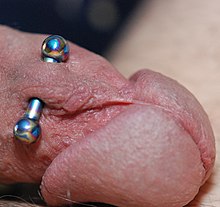Frenulum piercing
| Frenulum piercing | |
|---|---|

|
|
| location | Frenulum |
| Jewellery | Ball Closure Ring, Barbell, Circular Barbell, Curved Barbell Note on jewelry |
| Healing time | 2 to 4 weeks note on healing time |
| ‣ Topic overview | |
A frenulum piercing is a piercing of the foreskin ligament (frenulum) on the penis .
history
The first reports about frenula piercing date from the 19th century. The journal for ethnology reported on the Batta, an ethnic group from Timor, who “provided the frenulum behind the acorn with brass rings” . The reason for this is "an increase in sexual stimulation during sexual intercourse" .
Today it is a very popular genital piercing for men.
placement
It is pricked a little below the foreskin ligament to avoid tearing the thin ligament. Piercing the thin skin is very straightforward and heals very quickly, usually within four to eight weeks. In circumcised men, frenula piercing is only possible if there is still enough ribbon.
Jewellery
For the first piercing, the jewelry to be worn should have a diameter of 1.6 millimeters. Later, when the puncture canal has healed, the canal should be widened in order to wear a barbell, ring or similar jewelry in a stronger design. Material thicknesses between 2.4 and 3.2 millimeters should not be exceeded so that the piercing is not perceived as annoying during sexual intercourse, does not hurt and the jewelry is not torn from the foreskin frenulum.
variants
A frenum ladder consists of a series of several frenum piercings below the foreskin frenum along the shaft. The further down a piercing from the frenulum, the greater the risk that the jewelry will grow out due to the relatively high tension.
The lorum is pierced at the point between the penis shaft and scrotum and can therefore also be viewed as a variation of the Hafada piercing . The term is a suitcase word made up of "low" and "frenum".
See also
Web links
Individual evidence
- ↑ Bernhard Hagen: The artificial disfigurements of the body with the Batta . In: Journal of Ethnology . Volume 16, Berlin 1884, pp. 217-225
